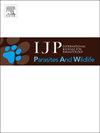有袋小锥虫的分子诊断揭示了哥伦比亚桑坦德市布卡拉曼加市区克氏锥虫传播和与朗格里锥虫同域传播的危险区域
IF 2
3区 医学
Q3 ECOLOGY
International Journal for Parasitology-Parasites and Wildlife
Pub Date : 2025-04-14
DOI:10.1016/j.ijppaw.2025.101072
引用次数: 0
摘要
野生动物对城市环境的适应可导致与人类的接触增加,并增加接触人畜共患病病原体的风险。有袋负鼠是克氏锥虫和利什曼原虫的重要宿主,它们通常影响拉丁美洲的人类种群。因此,本研究旨在评估来自哥伦比亚桑坦德市布卡拉曼加大都会区(MAB)的普通负鼠的锥虫感染频率和克氏锥虫dtu特征。对来自4个市(布卡拉曼加、佛罗里达布兰卡、Girón和Piedecuesta)的70人进行了血样PCR分析,其中14.3% (95% CI: 7.95 - 24.3%)的人检测出锥虫阳性。新一代测序阳性标本18S和Hsp70基因分别鉴定出9例(12.9%,95% CI: 6.91 ~ 22.66%)和2例(2.86%,95% CI: 0.79 ~ 9.83%)克氏T. DTU TcI和T. rangeli,其中1例合并感染(1.43%,95% CI: 0.04 ~ 7.7%)。热图显示,在布卡拉曼加邻近森林地区的周边社区,克鲁兹弓形虫阳性病例高度集中。该研究证实了克氏弓形虫在单抗中存在一个地方性传播周期,突出了有袋袋弓形虫作为一个重要宿主的作用,特别是在布卡拉曼加周边社区。克氏T.和兰格里T.在非洲单克隆抗体负鼠中的同域循环为这些地区的恰加斯病控制带来了新的流行病学挑战,强调需要改进诊断策略,以区分患者体内的寄生虫和包括媒介和宿主在内的流行病学研究。本文章由计算机程序翻译,如有差异,请以英文原文为准。

Molecular diagnosis of trypanosomatids in Didelphis marsupialis reveals risk areas for Trypanosoma cruzi transmission and sympatric circulation with T. rangeli in the metropolitan area of Bucaramanga, Santander, Colombia
The adaptation of wild animals to urban environments can lead to increased contact with humans and a higher risk of exposure to zoonotic agents. Didelphis marsupialis (common opossum) is an important reservoir of Trypanosoma cruzi and Leishmania spp., which commonly affect human populations in Latin America. Therefore, this study aimed to assess the frequency of trypanosomatid infections and characterize T. cruzi DTUs in common opossums from the Metropolitan Area of Bucaramanga (MAB), Santander, Colombia. A total of 70 individuals from four municipalities (Bucaramanga, Floridablanca, Girón, and Piedecuesta) were analyzed by PCR using blood samples, of which 14.3 % (95 % CI: 7.95–24.3 %) tested positive for trypanosomatids. Next-generation sequencing of 18S and Hsp70 genes in positive samples identified T. cruzi DTU TcI and T. rangeli in nine (12.9 %, 95 % CI: 6.91–22.66 %) and two (2.86 %, 95 % CI: 0.79–9.83 %) samples, respectively, including one case of co-infection (1.43 %, 95 % CI: 0.04–7.7 %). A heatmap revealed a high concentration of T. cruzi-positive cases in peripheral neighborhoods of Bucaramanga adjacent to forested areas. This study confirms the presence of an enzootic transmission cycle of T. cruzi in the MAB, highlighting the role of D. marsupialis as an important reservoir, particularly in peripheral neighborhoods of Bucaramanga. The sympatric circulation of T. cruzi and T. rangeli in opossums from the MAB introduces new epidemiological challenges for Chagas disease control in these areas, emphasizing the need for improved diagnostic strategies to differentiate both parasites in patients and epidemiological studies including vectors and reservoirs.
求助全文
通过发布文献求助,成功后即可免费获取论文全文。
去求助
来源期刊

International Journal for Parasitology-Parasites and Wildlife
Medicine-Infectious Diseases
CiteScore
3.80
自引率
5.60%
发文量
113
审稿时长
45 days
期刊介绍:
The International Journal for Parasitology: Parasites and Wildlife (IJP-PAW) publishes the results of original research on parasites of all wildlife, invertebrate and vertebrate. This includes free-ranging, wild populations, as well as captive wildlife, semi-domesticated species (e.g. reindeer) and farmed populations of recently domesticated or wild-captured species (e.g. cultured fishes). Articles on all aspects of wildlife parasitology are welcomed including taxonomy, biodiversity and distribution, ecology and epidemiology, population biology and host-parasite relationships. The impact of parasites on the health and conservation of wildlife is seen as an important area covered by the journal especially the potential role of environmental factors, for example climate. Also important to the journal is ''one health'' and the nature of interactions between wildlife, people and domestic animals, including disease emergence and zoonoses.
 求助内容:
求助内容: 应助结果提醒方式:
应助结果提醒方式:


